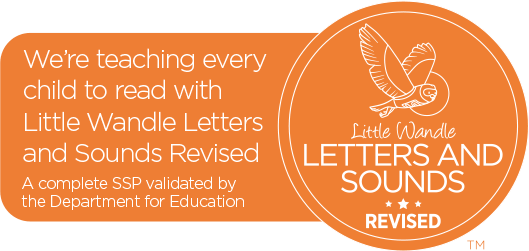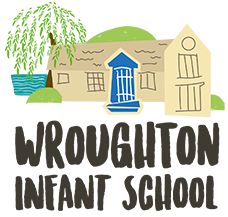Phonics and Reading
Vision
At Wroughton Infant School we value reading as a crucial life skill so it is essential that our approach to teaching phonics and reading is accessible to all learners, regardless of background.
We believe that all our children can become fluent in their reading, read for meaning and regularly enjoy reading for pleasure and purpose.
We ensure our classrooms are language rich environments, supporting the children in learning and understanding new vocabulary.
Parents Phonics Workshop Slides -30th January 2025
Please find attached the Phonics Workshop Presentation slides and more.
Phonics Workshop Presentation- 30.01.25
how to say the phase 5 sounds september 2022.pdf
tricky words for parents phase 5.pdf
Phonics (Word Reading)
At Wroughton Infant School, we believe that all our children can become fluent readers and writers.
We start teaching phonics in Reception. By following the Little Wandle Letters and Sounds Progression, we ensure that children master phonics in order to read and spell.
We ensure that the children know the alphabetic code - the relationship between the sounds that can be identified in speech (phonemes) and the letters used to represent them in writing (graphemes).
Our children will be able to tackle unknown words as they read, as well as being able to read tricky words on sight.
Children will be taught to read fluently, ensuring they read accurately and at a speed that allows them to comprehend what they have read.
Once our children have developed fluency in reading, they will also be taught to read with prosody - the rhythmic and intonational aspect of speech that manifests as expression.

Comprehension
We ensure children develop their language comprehension skills by listening to and reading stories and having high-quality discussions about what they have read.
The children are encouraged to show their understanding of what they have read, or had read to them, by retelling parts of the text, answering questions about the text and making predictions based on what they have read or heard.
We support children to ensure they read with appropriate fluency and speed to enable them to comprehend/understand what they are reading. The children's vocabulary is developed across the curriculum to support their comprehension skills.
Implementation
Daily Phonics in Reception and Year 1
We teach phonics for 30 minutes a day. In Reception, we build from 10-minute lessons, with additional daily oral blending games, to the full-length lesson as quickly as possible. Each Friday, we review the week’s teaching to help children become fluent readers.
Children make a strong start in Reception: teaching begins in Week 2 of the school year.
We follow the Little Wandle Letters and Sounds Revised expectations of progress:
- Children in Reception are taught to read and spell words using Phase 2 and 3 GPCs, and words with adjacent consonants (Phase 4) with fluency and accuracy.
- Children in Year 1 review Phases 3 and 4 and are taught to read and spell words using Phase 5 GPCs with fluency and accuracy.
Daily Keep Up Sessions
Any child who needs additional practice has daily Keep-up support, taught by a fully trained adult. Keep-up lessons match the structure of class teaching but in smaller steps with more repetition.
We timetable daily phonics lessons for any child in Year 2 who is not fully fluent at reading or has not passed the Phonics screening check.
Reading Practice Sessions
We teach children to read through reading practice sessions three times a week. These:
- are taught by a fully trained adult to small groups of approximately six children
- use books matched to the children’s secure phonic knowledge using the Little Wandle Letters and Sounds Revised assessments and book matching.
Each reading practice session has a clear focus, so that the demands of the session do not overload the children’s working memory. The reading practice sessions have been designed to focus on three key reading skills:
- decoding
- prosody: teaching children to read with understanding and expression
- comprehension: teaching children to understand the text.
In Years 2, we continue to teach reading in this way for any children who still need to practise reading with decodable books.
Assessment
Assessment for Learning is used daily within class to identify children needing Keep-up support and weekly in the Review lesson to assess gaps, address these immediately and secure fluency of GPCs, words and spellings.
Summative assessments take place every six weeks to assess progress, to identify gaps in learning that need to be addressed, to identify any children needing additional support and to plan the Keep-up support that they need.
At the end of year one, the children sit the statutory phonics screening check. If they do not pass this, they will repeat it in year 2.
Home Reading
Reading a book and chatting about it has a positive impact on children's ability to:
- understand words and sentences
- use a wide range of vocabulary
- develop listening comprehension skills
Your child will bring two books home from school each week; a phonics book chosen by the teacher and a sharing book they have chosen themselves from our school library.
Phonics Book: your child should be able to read this book to you without help. If they can't read a word, read it to them. Talk about the book and celebrate their success.
Sharing Book: this book is for you to read! Make the story sound as exciting as you can by changing your voice and talk with your child as much as you can.
Please complete your child's reading record each time they read their phonics book.
Each time your child completes 20 reads, they will receive a certificate.
Reading for Pleasure
Each day in class, we share stories to enjoy together. Each week, the children get to visit our well stocked school library to choose books to read for enjoyment with their family at home. Each year, we celebrate World Book Day and celebrate our love of books!
Resources to Support Reading at Home
Letters, Sounds & Phonics Presentation for Parents
Little Wandle Letters and Sounds Parent Information
wis eyfs recommended reads poster.pdf
wis year 1 recommended reads poster.pdf
wis year 2 recommended reads.pdf
